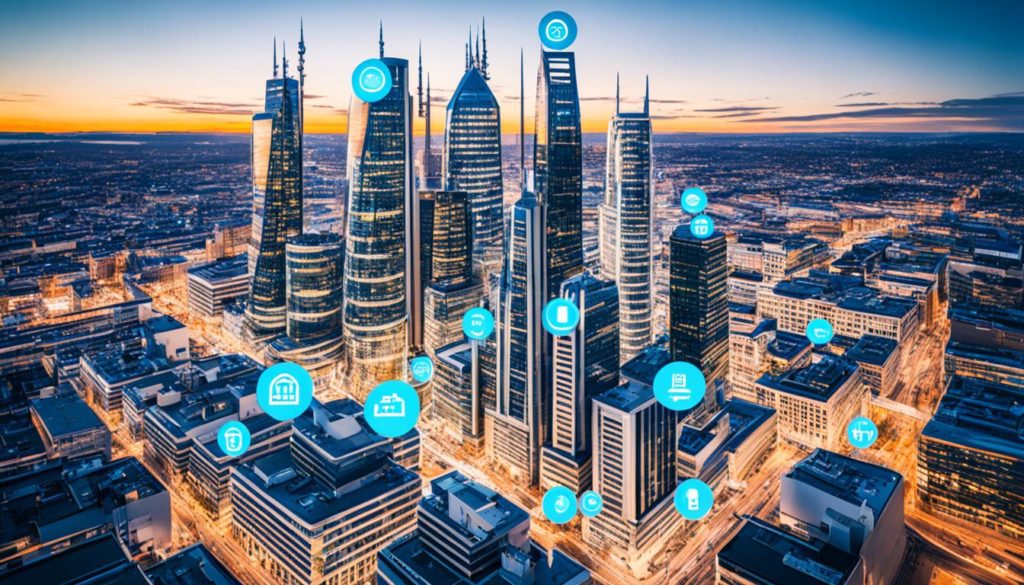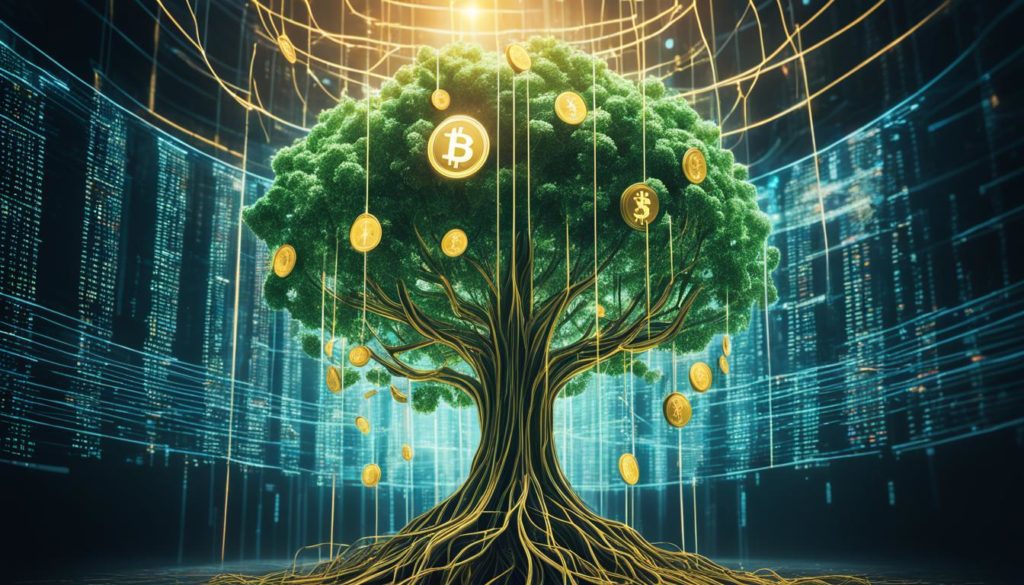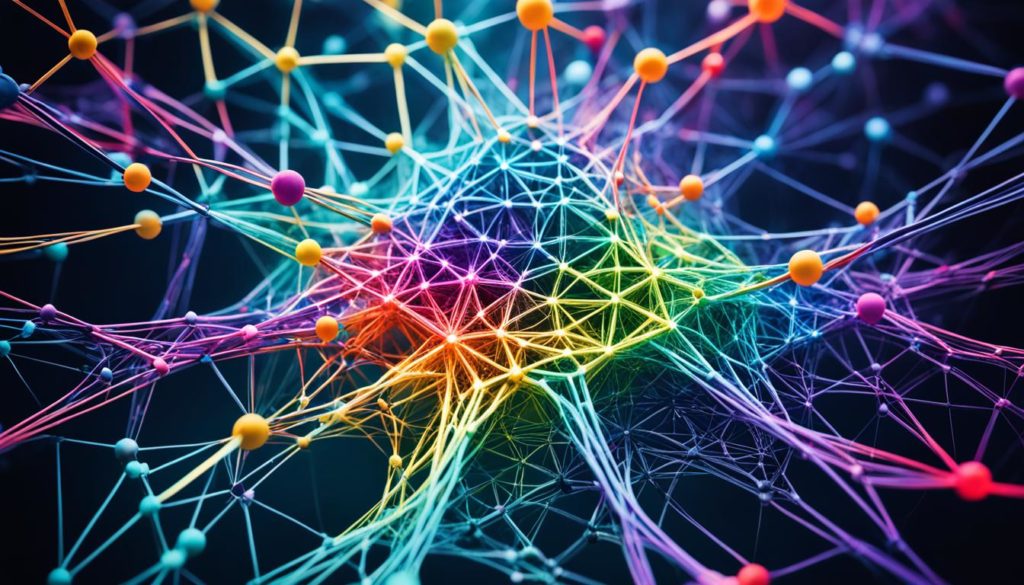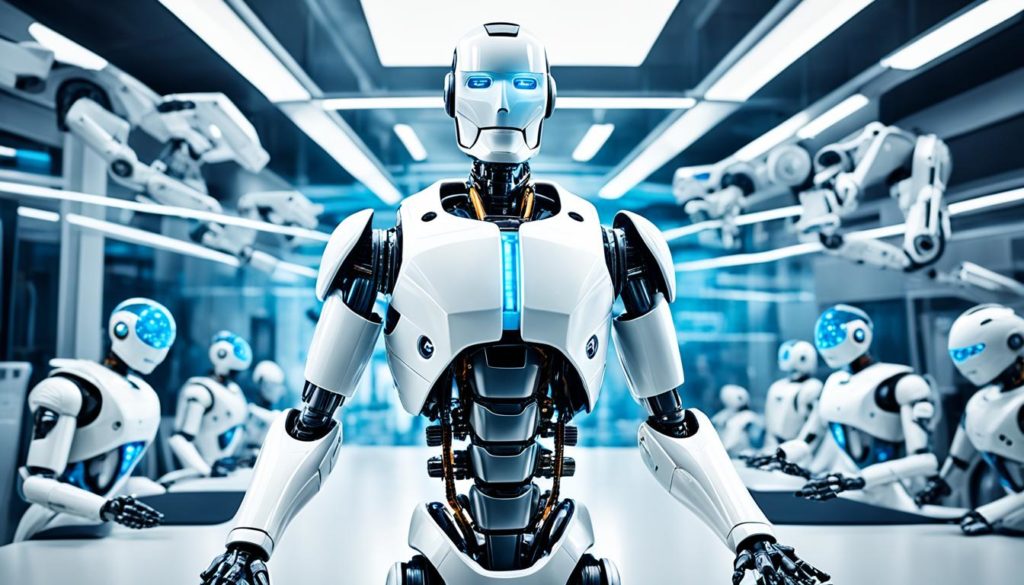
By 2025, 75% of enterprise-generated data is expected to be handled outside usual data centers or clouds. This amazing fact highlights how IoT Edge Technology is changing the Internet of Things world. With the need for instant data processing growing, old cloud setups can’t keep up. They struggle with delays, limited data flow, and security risks.
IoT Edge Computing Solutions change the game by moving data processing closer to where the data is created. This change cuts down on lag, improves data flow, and boosts security. Imagine having instant data handling wherever your IoT gadgets are set up.
Key Takeaways
- Future prospects indicate 75% of data will be processed outside traditional data centers by 2025.
- IoT Edge Technology reduces latency by bringing data processing closer to the data source.
- Bandwidth optimization is a significant benefit provided by IoT Edge Computing Solutions.
- Enhanced security is another critical advantage of implementing Internet of Things Edge systems.
- Edge computing represents a pivotal shift that can streamline the success of interconnected devices.
The Rise of Edge Computing in IoT
More IoT devices mean a bigger need for quick, real-time data handling. This has led to the growth of Edge Computing Services. They make computing power closer to where data is made. This change reduces delays, boosts bandwidth efficiency, and makes data safer.
The Need for Real-Time Processing
The explosion of IoT devices makes Real-Time IoT Data Analytics crucial. Edge computing helps with this by having edge devices close to users. It lets data be processed and stored right away, cutting down on the need for central servers. This helps self-driving cars, industrial automation, and augmented reality work better and faster.
About 80 percent of data will be handled where it’s made by 2023. Edge computing is key for managing the massive amount of data from IoT devices. Also, national security agencies and areas like healthcare, retail, and manufacturing use edge computing. They do this to get better at operations and make quicker decisions.
Challenges of Traditional Cloud Architectures
Traditional cloud setups don’t always work well for cloud vs edge computing. This is especially true when you need to process data right away. Cloud computing’s central setup can cause delays. It’s because data has to move back and forth between the device and the server. This wait doesn’t work for things that need quick answers, like self-driving cars or watching patients in real-time.
Edge computing lessens security risks by handling data locally. This is important in fields that deal with private information. By processing data on-site, edge computing also reduces costs. It cuts down on the need for moving and storing lots of data.
| Criteria | Cloud Computing | Edge Computing |
|---|---|---|
| Processing Speed | High Latency | Low Latinity |
| Data Security | Higher Risk | Enhanced Security |
| Cost Efficiency | Higher Costs | Cost Savings |
| Bandwidth Usage | Higher | Lower |
| Scalability | Lower | Higher |
Benefits of IoT Edge Computing
IoT Edge computing offers many benefits that change how we handle data. It moves computations closer to where data comes from. This change leads to better speed, optimization, and security for businesses.
Reduced Latency
One top benefit of IoT Edge is Low-latency Edge Computing. This means data is processed right where it’s collected. Because of this, edge computing makes data analysis and decisions very fast. It’s key for things like self-driving cars and factory automation.
Bandwidth Optimization
IoT Edge also helps use bandwidth better. It cuts down the amount of data sent to the cloud. This reduces network traffic. It’s great for areas with poor internet, ensuring smoother operations and better use of bandwidth.
Enhanced Security
Edge computing is vital for Secure IoT Solutions. It processes data on local devices, keeping sensitive information safe. This way, it lessens the chance of data leaks during transfers. It also makes it easier for organizations to follow strict privacy laws, crucial in healthcare and finance.
Edge Computing Devices: Key Components
In the world of IoT, edge devices play a critical role. They allow for data processing and storage right where it happens. This means we don’t rely just on big data centers far away. These devices help industries see important info in real-time, make things run smoother, and get more done.
- Edge Gateways: They serve as a link, making sure data moves smoothly between local devices and the cloud.
- Edge Sensors: Placed all around, they collect vital information. This is true whether it’s in factories, hospitals, or in self-driving cars.
- Edge Servers: These are powerful machines that take on big computing jobs on-site. This cuts down delay and saves on internet bandwidth.
Putting these edge components together offers big benefits, like:
- Faster Decision-Making: With local data processing, edge devices provide immediate insights. This is key for things like keeping machines running smoothly and self-driving safely.
- Improved Data Security: Handling data locally means it’s safer. There’s less risk of sensitive info getting exposed over public internet channels.
- Operational Efficiency: Less need for cloud computing means we use internet bandwidth better. It makes IoT systems work smoother and faster.
Getting Edge Computing Products and IoT Edge Hardware set up right is essential. It helps make modern IoT solutions work well in all kinds of industries.
Real-World Applications of Edge Computing
Edge Computing Applications have created many chances for change in different areas. By handling data near its source, edge computing cuts down delay. It also makes data safer, helping businesses work better and improve services.
Predictive Maintenance
Predictive maintenance uses sensors to find equipment issues in real-time and predict possible breakdowns. It keeps crucial systems running well. This reduces downtime and saves money on repairs. Edge computing lets industries monitor conditions closely. This results in better production processes.
Smart Cities
Edge computing transforms smart cities by improving energy use and reducing traffic jams. IoT Smart Solutions help cities manage power better and save money. They also track pollution and fix problems fast.
Such systems allow buildings to use IoT for smarter energy use, better security, and full remote control.
Autonomous Vehicles
Self-driving cars depend on Autonomous Edge Computing for quick data handling. This is key for safety and smooth driving. Fast data processing helps cars make decisions quicker, with less delay. It also makes them use less energy and cost less to run.
Edge computing advances help cars get better, including things like driver help and constant vehicle checks. This makes driving safer and enhances the driving experience.
IoT Edge Computing: A Paradigm Shift
The arrival of IoT Edge Computing marks a major change towards decentralized data processing. This change is transforming the IoT world, allowing data analysis to happen immediately where data is created. Focusing on processing data locally, the IoT Edge Computing Revolution aims to change many industries by lessening the need for centralized cloud services.
By using Distributed Edge Computing, we can unlock IoT’s full potential. These technologies help build a complete ecosystem for IoT devices. They let us design personalized setups that improve app speed, reliability, and safety. This is especially useful in areas like healthcare, manufacturing, and smart cities, where fast data processing and minimal delay are essential.
One big plus of the IoT Edge Computing Revolution is much better processing speed. It cuts down on data travel and eases network traffic, leading to quicker reactions and more efficient use of resources. Edge computing also boosts security by keeping data storage and processing close by. This way, it avoids the security risks of sending data over long distances.
To see the difference, look at this comparison:
| Traditional Cloud Computing | IoT Edge Computing |
|---|---|
| Centralized Data Processing | Distributed Edge Computing |
| Higher Latency | Low Latency |
| Bandwidth Intensive | Optimized Bandwidth Usage |
| Potential Security Risks | Enhanced Security with Localized Data Processing |
| Dependent on Network Reliability | Resilient to Network Disruptions |
Looking ahead, using IoT Edge Computing strategies will let us innovate in smarter and more sustainable ways. This shift isn’t just about new technology. It’s about creating environments that are clever, safe, and quick to respond to our needs in the future.
Challenges with Edge Computing Solutions
Implementing edge computing in IoT has many benefits. But, it also comes with challenges that need addressing. This ensures edge solutions work well and efficiently.
Connectivity Issues
Edge computing needs stable network connections. Any disruptions can cause major issues. Without good connectivity, real-time processing and quick responses can’t happen. This wastes edge computing’s main benefits.
Scalability and Management
The growth of IoT devices brings IoT Scalability Challenges. Managing more devices in different places gets complex. To keep things running smoothly, we need better management tools and strategies.
Data Governance
IoT Data Governance is crucial, yet challenging. With edge processing, sticking to data protection laws gets complicated. Good governance frameworks are needed. They help manage data securely and control who can access it.
| Challenge | Details | Impact |
|---|---|---|
| Connectivity Issues | Unstable network connectivity can disrupt edge computing. | Compromises real-time processing and low latency benefits. |
| Scalability and Management | Complexity increases with the expansion of IoT devices. | Requires advanced management tools for efficient operations. |
| Data Governance | Challenging to maintain compliance with processing data at the edge. | Ensure robust governance frameworks for data protection. |
Future Trends in IoT Edge Technology
The future of IoT edge technology is closely linked to 5G networks. This change will make our devices connect faster and work better. It promises a smoother experience for people all over the world.
Integration with 5G Networks
Integrating 5G will change how we connect, says 5G networks. By the end of 2023, we expect 2 billion 5G connections. They will grow to 8 billion by 2026. This will help apps that need a lot of bandwidth and make networks much better.
This better connection is key for cars, health, making things, and stores. Spending on edge computing will jump from $208 billion in 2023 to about $317 billion by 2026. The 5G rollout makes new apps possible. It leads to smarter, self-working edge devices.
AI and Machine Learning at the Edge
AI and machine learning are teaming up with edge computing. We’re seeing AI-driven IoT apps that make quick, smart decisions. IDC says, data made at the edge will grow fast by 34% each year till 2027. This shows we’ll rely more on AI solutions.
Machine learning is sparking new ideas in predictive maintenance. Devices can now spot problems early and fix them without help. Edge AI is getting big. Companies like EDGENeural.ai and Tercero are leading the way. They’re making industries more efficient and innovative.
IDC expects 157 zettabytes of data by 2024, with 20% from the edge. This mix of machine learning IoT trends and edge computing is making IoT systems smarter. It also brings big economic benefits.
Conclusion
IoT Edge Computing is changing the tech world fast. It lets us process data in real-time, avoiding the limits of old cloud setups. This is a huge step towards a smarter, more linked world. Benefits include less delay, better bandwidth use, and stronger security.
The future looks bright with 5G, AI, and machine learning joining forces with IoT Edge Computing. These tools promise big gains in how well things work. They’ll bring about smart cities, better preventive maintenance, and self-driving cars. This is how IoT’s future advancements will change our industries and tech scene.
It’s not all smooth sailing, with hurdles like connection problems, scaling up, and managing data. Yet, the good outweighs the bad. By adopting IoT Edge advancements, we’re leading in innovation. We’re creating a brighter future with IoT Edge Computing, which promotes growth and tech progress.
FAQ
What is IoT Edge Computing?
A: IoT Edge Computing means processing data near where it’s collected. It’s done by sensors or devices in the Internet of Things (IoT) world. This tactic cuts down on delay, lowers data use, and boosts data safety.
Why is real-time processing important for IoT?
Real-time processing is key for IoT. It allows for quick decision-making. This is a must for things like self-driving cars, smart cities, and keeping machines running smoothly. It cuts down delays and makes IoT devices act faster.
How does edge computing compare with traditional cloud computing for IoT?
With traditional cloud computing, data processing is central. This can cause delays and up data usage. But, edge computing handles data on local devices. This reduces wait times, saves on data, and helps keep things secure.
What are the benefits of IoT Edge Computing?
The big pluses include less delay, better data use, and stronger security. These benefits are crucial for IoT tasks that need quick responses.
What types of edge computing devices are commonly used?
Common devices are gateways, edge servers, and special hardware. They have processing power and storage. These are used in areas like making goods and self-driving cars.
Can you provide examples of real-world applications of edge computing?
Sure, real-world uses include spotting equipment issues early, managing energy and traffic in smart cities, and self-driving cars that process data fast for safety and efficiency.
How does IoT Edge Computing represent a paradigm shift?
It’s a big change from centralized to decentralized data handling. This is key to getting the most from IoT. It leads to better performing apps and connects things more closely.
What are the challenges associated with edge computing solutions?
The main hurdles are connectivity problems, tricky scaling and management, and tight data control. Strong networks and smart management tools are vital to tackle these.
What future trends can we expect in IoT Edge Technology?
Expect tighter 5G network integration, boosting connection and processing. Also, merging AI and machine learning with edge tech will create smarter, quicker IoT setups.
Future App Studios is an award-winning software development & outsourcing company. Our team of experts is ready to craft the solution your company needs.










